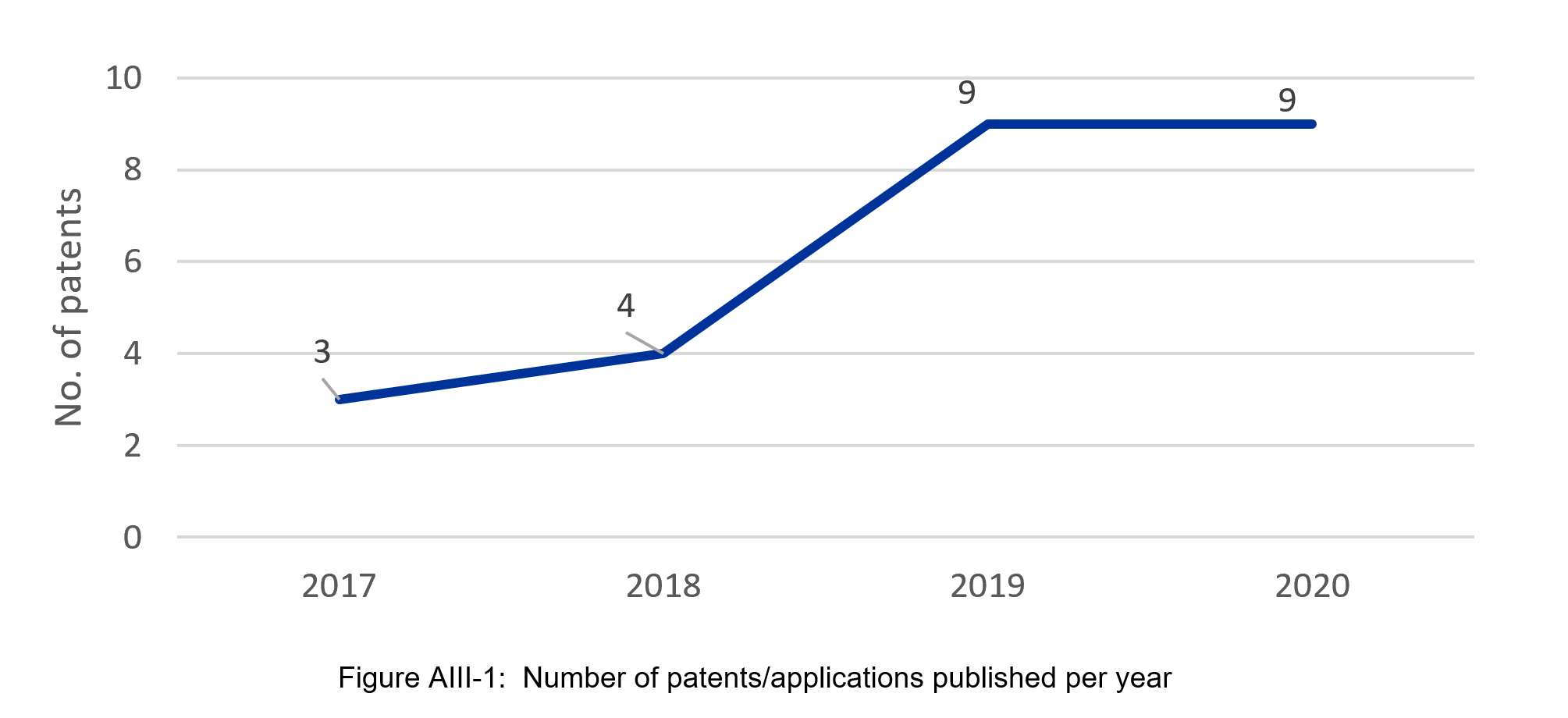Patents - EUON
Textiles
This section looks at the patenting activity in the field of nanotechnology and textiles between 2017-2020. Granted patents and patent applications focused on textiles and nanotechnology were extracted from the general collection of nanotechnology patents from 2017-2020 developed by the study team for the database. The patents were collected from Espacenet database maintained by the European Patent Office.
The dataset of patents on textiles and nanotechnology was developed by extracting the granted patents and patent applications that contained the CPC classes and sub-classes dedicated to textiles in their bibliographic information. It should be noted that most nanotechnology patents contain multiple classes in their subject descriptions. As finished consumer products that cover clothes (e.g., shirts, underwear, baby linen, etc.) and headwear (hats, head coverings, etc.) textiles are listed under 41-A42 CPC classes.
| Table AIII-3: Textiles in the Cooperative Patent Classification (CPC)1 | |
|---|---|
| Class | Title |
| A41 | Wearing apparel |
| A42 | Headwear |
Patents on nanotechnology in Textiles
As a result of patent collection mining, 25 patent applications and granted patents published from2017-2020 were identified. The number of patents and patent applications containing textiles classifications was steadily low in the period under analysis.

Most patents/applications (15, 60%) were published in the national patent offices, while the rest were in the World Intellectual Property Organisation (WIPO, 8, 32%) and the European Patent Office (2, 8%).
China (8 applications, 32%) prevailed among the countries where most patent applications were published. Other countries, such as the USA (4, 16%), South Korea (2, 8%) and Czech Republic (1, 4%) published fewer patents/applications.
Patent applications and granted patents contained two CPC sub-classes referring to textiles. All patents/applications (24, 96%) focused on wearing apparel, while only one – on headwear. It should be noted that most patents/applications focused on protective clothing, such as e.g., face masks.
| Table AIII-4: Examples of patents focused on A41 sub-class | |
|---|---|
| Bibliographic information | Abstract |
| Xiao, K. et al. (2020). Non-dissolution type long-acting antibacterial protective non-woven fabric and preparation method and application thereof. No. CN111424432A. Available here. (Patent application) |
The invention belongs to the technical field of antibacterial materials and discloses a non-dissolution type long-acting antibacterial protective non-woven fabric and a preparation method and application thereof. The preparation method comprises the following steps that antibacterial liquid is evenly sprayed on a non-woven fabric or the non-woven fabric is soaked in the antibacterial liquid, and organic silicon molecular polymerization is carried out to enhance the binding force of non-woven fabric fibre and antibacterial active substances; and high-temperature setting is performed, and the antibacterial active substances such as ammonium salt and nano-silver are loaded on the surface of the non-woven fabric in a directional mode to prepare the antibacterial protective non-woven fabric, wherein the antibacterial liquid comprises nano-silver gel, quaternary ammonium salt, organic silicon, an auxiliary agent and water. According to the method, the high-activity quaternary ammonium salt and the nano-silver are loaded on the surface of the non-woven fabric fibre to form an ultra-thin positively charged antibacterial layer through chemical bonding of the organic silicon on the surface of the polymer fibre, the structure of the non-woven fabric fibre is basically not damaged, the good air permeability is maintained, meanwhile, the rejection rate of the protective non-woven fabric can be remarkably improved, and masks prepared from the non-woven fabric can be repeatedly used. |
| Swogger, K. et al. (2020). Personal protective equipment with functionalized nanotube compositions to control pathogens such as SARS CoV-2 (coronavirus). No. US10757988B1. Available here. (Granted patent) |
Nanotube compositions may be employed in many different forms alone, and/or with surfactants, with antiviral metals, with antigens, and/or with various drugs to control pathogens like viruses e.g., SARS COVID-2, bacteria, mold, fungi, chemical or biological agents etc in masks or other personal protection equipment. The personal protection equipment such as masks reduce, control, absorb, deactivate, detoxify, and/or kill the pathogens such that a pathogen or pathogens deleterious effects are reduced and/or eliminated to a user of the mask. |
Textile innovation breakthroughs in patents
Innovation breakthrough is a particular type of innovation that has a profound effect on subsequent inventions, products and services. Three indicators of patents were studied to identify innovation breakthroughs – number of forward citations, number of citing organisations and number of citing countries. The study did not identify innovation breakthroughs in textiles patents from 2017-2020.
1 European Patent Office. (2022). Cooperative Patent Classification, A: Human necessities agriculture. Available at: https://www.cooperativepatentclassification.org/sites/default/files/cpc/scheme/A/scheme-A.pdf


